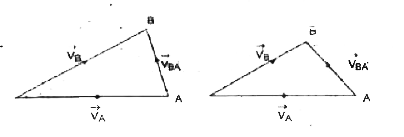A body moves due East with velocity 20km/hour and then due North with velocity 15km/hour. The resultant velocity
5km/hour
15km/hour
20km/hour
25km/hour
The correct Answer is:D
Step by step video, text & image solution for A body moves due East with velocity 20 km//hour and then due North with velocity 15 km//hour. The resultant velocity by Physics experts to help you in doubts & scoring excellent marks in Class 11 exams.
Topper's Solved these Questions
Similar Questions
Afrala moves due east with a velocity 20 m/s and a car moves due north with a velocity v2=15m/sec. Find the velocity of the car as observed by a passenger sitting in the train
View SolutionAnoop is moving due east with a velocity of 1m/s and Dhyani is moving due west with a velocity of 2m/s. what is the velocity of Anoop with respect to Dhyani?
View Solution
Knowledge Check
- Question 1 - Select One
A car A moves along north with velocity 30 km/h and another car B moves along east with velocity 40 km/h. The relative velocity of A with respect to B is
A50 km/h North - EastB50 km/h North-WestC50 km/h at angle tan−1(3/4) North of WestD50 km/h at angle tan−1(3/4) West of North - Question 2 - Select One
The vector difference between the absolute velocities of two bodies is called their relative velocity. The concept of relative velocity enables us to treat one body as being at rest while the other is in motion with the relative velocity. This jormalism greatly simplifies many problems. If →vAis the absolute velocity of a body A and →–––(B)that of another body B then the relative velocity of A in relation to B is →–––(AD)=→VA−→vB and →vBA=→vB-→vA.
The principle follows here is that the relative velocity of two bodies remains unchaged if the same additional velocity is imparted to both the bodies. A simple way of carrying out this operation is to be represent the velocities in magnitude and direction from a common point. Then the line joining the tips of the vectors represents the relative velocity
Q A train A moves to the east with velocity of 40 km/hr and a train B moves due north with velocity of 30 km/hr. The relative velocity of A w.rt. B is A70 km/hr towards EastB10 km/hr towards North EastC50 km/hr at some angle South of EastD50 km/hr at some angle North of East.
A70 km/hr towards EastB10 km/hr towards North EastC50 km/hr at some angle South of EastD50 km/hr at some angle North of East. - Question 3 - Select One
A flag is mounted on a car moving due North with velocity of 20km/hr. Strong winds are blowing due East with velocity of 20km/hr. The flag will point in direction
AEastBNorth-EastCSouth-EastDSouth-West
A flag is mounted on a car moving due North with velocity of 20km/hr. Strong winds are blowing due East with velocity of 20km/hr. The flag will point in direction
View SolutionSeeta is moving due east with a velocity of V1m/s and geets iss moving due west with velocity of V2m/s. The velocity of Seeta with respect to Geeta is
View SolutionA body moves with a velocity of 3m/s due east and then turns due north to travel with the same velocity. If the total time of travel is 6s. The acceleration of the body is
View SolutionA bird is flying towards south with a velocity 40km/hr and a train is moving with a velocity 40km/hr towards east. What is the velocity of the bird w.r.t. an obserber in train:-
View SolutionA bird is flying towards south with a velocity 40km/h and a train is moving with a velocity 40 km/h towards east. What is the velocity of the bird w.r.t. an obserber in the train ?
View Solution

